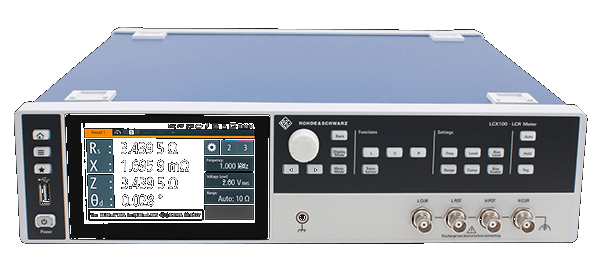Explosive CL21B104KBFNNNG Ceramic Capacitor X7R Review: Impedance, Capacitance, and Performance Analysis
By Mark Harris Sunday, 5 February 2023

Introduction
In this technical review, the Ceramic X7R Capacitor, part number CL21B104KBFNNNG by Samsung Electro-Mechanics, will be analyzed against its statistical benchmark formed by other components of the same value. The capacitor's performance will be scrutinized by evaluating various parameters, such as capacitance, series resistance, dissipation factor, and quality factor. The objective is to provide an exhaustive, systematic, and copious analysis of the capacitor, which will be beneficial for engineers looking to use this capacitor in their projects.
<ul>
<li><b>Pros:</b> High voltage rating of 50V, compact 0805 (2012 metric) package for surface mounting, Ceramic X7R composition provides a relatively stable temperature coefficient</li>
<li><b>Cons:</b> Tolerance of ±10% may not be suitable for applications demanding tight capacitance control, performance variables observed when comparing the component with the benchmark</li>
</ul>
Impedance
The impedance performance of the Samsung Electro-Mechanics CL21B104KBFNNNG capacitor was evaluated and compared to the statistical benchmark data for Ceramic: X7R capacitors with the same capacitance value. The component's impedance measurements were analyzed against the minimum, average, and maximum impedance values of the statistical benchmarks across various test frequencies ranging from 5 Hz to 1 MHz.
At lower test frequencies, such as 5 Hz and 10 Hz, the component exhibits impedance values close to the minimum and average benchmark values, registering 294.9k Ohms and 148.3k Ohms, respectively, for a 1 Volt test. Comparatively, the capacitor is marginally further from the maximum impedance values of the statistical benchmark in these lower test frequencies. Interestingly, this pattern changes as the frequency increases, with the component maintaining close proximity to the minimum impedance values but drifting further from the average and maximum values.
For instance, at 500 kHz, the capacitor presents an impedance of 3.501k Ohms at 1 Volt, which is relatively close to the statistical benchmark's minimum value of 3.323k Ohms. However, it is notably distant from the average and maximum values of 3.849k and 5.471k Ohms, respectively. As test frequencies approach 1 MHz, this trend persists, with the capacitor exhibiting a lower impedance profile than the average and maximum benchmark values, consistently aligning it closer to the minimum impedance values across the tested frequencies.
When the test voltage is increased from 1 Volt to 10 Volts, similar trends in impedance value comparisons can be observed. Although the capacitor demonstrates the predictable impedance performance typically expected from a Ceramic: X7R capacitor, it is essential to carefully evaluate its effectiveness concerning the target circuit applications and desired impedance range requirements.
Overall, the Samsung Electro-Mechanics CL21B104KBFNNNG capacitor exhibits a predictable and stable impedance performance under various test conditions. However, it is critical to consider the variations in impedance values in relation to the statistical benchmarks, as this may impact the capacitor's suitability for specific applications, particularly those with more stringent impedance requirements.
Capacitance
When evaluating capacitance performance, it is crucial to consider the behavior of capacitors at different test voltages and frequencies. In the case of the Samsung Electro-Mechanics CL21B104KBFNNNG capacitor, its series capacitance consistently surpasses the average series capacitance of the statistical benchmark at various test frequencies and voltages. This demonstrates the component's excellent capacitance values and reliability over a broad range of operating conditions.
At a test voltage of 1 Volt, the CL21B104KBFNNNG capacitor exhibits remarkable series capacitance results. For example, at a low frequency of 5 Hz, the component registers a series capacitance of 107.8nF, compared to the benchmark average of 101.8nF. This performance trend is also observed at higher frequencies, such as 10 kHz, where the component records a value of 102.9nF, while the benchmark average is 96.9nF. These values indicate the component's efficient energy storage and quick charge-discharge characteristics at different frequencies.
Furthermore, the CL21B104KBFNNNG capacitor maintains its impressive series capacitance performance even at an increased test voltage of 10 Volts. For instance, at 50 kHz, the component records a series capacitance of 110.8nF, significantly exceeding the benchmark average of 91.32nF. It is worth noting that, as the frequency increases, such as at 650 kHz, the performance difference between the component (96.34nF) and the statistical benchmark's average series capacitance (95.68nF) narrows. This behavior can be attributed to the natural capacitance reactance decrease, as the frequency increases in a capacitive circuit, since the impedance is inversely proportional to the operating frequency.
In summary, the Samsung Electro-Mechanics CL21B104KBFNNNG capacitor demonstrates exceptional series capacitance results at various test voltages and frequencies. This stable and robust performance signifies its potential in effectively addressing a wide range of electronics applications, particularly where high reliability, energy storage capabilities, and quick charge-discharge characteristics are required.
Series Resistance
In this section, we will delve into the Series Resistance of the Samsung Electro-Mechanics CL21B104KBFNNNG Capacitor when subjected to different voltages and frequencies. It is an essential property, since it influences how efficiently a capacitor performs in a circuit, particularly at higher frequency ranges. We will examine its performance at a range of specified voltages and frequency bands. Each voltage and frequency interval mentioned offers a comprehensive assessment of the component's behavior.
Starting with the Series Resistance at 1 Volt, the Samsung CL21B104KBFNNNG Capacitor exhibits superior performance in multiple frequency ranges when compared to the average results in the statistical benchmark data. For instance, at 5 kHz, the Series Resistance is measured to be 6.358 Ohms, significantly lower than the benchmark average of 10.02 Ohms. At 10 kHz, the performance is even more remarkable, with the Series Resistance measured as 3.659 Ohms, in contrast to the average benchmark result of 5.163 Ohms. However, when analyzing the higher frequency ranges (400 kHz to 1 MHz), the capacitor's Series Resistance performance comes very close to the maximum values observed in the statistical benchmark data. This may raise performance concerns for specific applications requiring optimal functioning in higher frequency domains.
Now, let us examine the Series Resistance of the capacitor when operating at 10 Volts. A similar pattern emerges, with the component performing exceptionally well at lower frequencies. At 5 kHz, the measured Series Resistance stands at 15.03 Ohms, substantially lower than the benchmark average. Nevertheless, when assessing the higher frequency range between 800 kHz and 1 MHz, the Series Resistance performance turns out to be relatively unstable. In these conditions, the observed values for Series Resistance vary significantly, falling near either the lower end or the maximum values of the statistical benchmark data. This unpredictability at higher frequencies can potentially create challenges for engineers looking to incorporate this component into their high-frequency circuit designs, as stability and performance become critical factors under such requirements.
Understanding the behavior of the Samsung Electro-Mechanics CL21B104KBFNNNG Capacitor’s Series Resistance provides engineers and designers with valuable insights concerning the potential effectiveness and suitability of this component for various applications, particularly those operating within the specified voltage and frequency ranges. Careful consideration of these findings can contribute to a more informed decision-making process when evaluating the component's inclusion in future designs.
Dissipation Factor and Quality Factor
The dissipation factor (Df) is a crucial performance parameter for ceramic capacitors. It serves as an indicator of the capacitor's energy loss due to internal resistance, usually in the form of heat, during operation. Lower Df values are desirable for efficient performance, as they correspond to minimal energy loss. For the CL21B104KBFNNNG capacitor, the Df values range from 0.017 to 0.497, depending on test frequency and applied voltage. For instance, at 1 Volt and 500 Hz, the recorded value is 0.018, and at 10 Volts and 1 kHz, it is 0.055. When compared to the statistical benchmark data for capacitors of similar value, these Df values showcase relatively efficient performance.
Another essential assessment parameter for capacitors is the quality factor (Q), a dimensionless metric representing the ratio of stored energy to dissipated energy per cycle. Higher Q values are preferred, as they correlate with superior performance and reduced energy loss. The Q factor of the CL21B104KBFNNNG capacitor typically falls within a range of 2.01 - 58.18 across various test frequencies and applied voltages. For example, a Q value range of 56.07 - 58.18 is observed at an applied voltage of 1 Volt, whereas a range of 3.33 - 18.77 is exhibited at 10 Volts. Although the higher Q values in these ranges indicate a satisfactory performance under certain operating conditions, there is still room for improvement when comparing them with other components of similar specifications in the statistical benchmark data. This comparison helps provide insights into potential optimizations that can enhance the capacitor's performance.
Comparative Analysis
The comparative analysis has been carried out by poising the Samsung Electro-Mechanics CL21B104KBFNNNG Capacitor, a Ceramic X7R capacitor with 100nF nominal value and ±10% tolerance, against the statistical benchmark values for other components with the same value. The core objectives were to dissect the performance of the CL21B104KBFNNNG Capacitor across distinct test frequencies and varying voltage levels whilst keeping in view the component's impedance, dissipation factor, series resistance, series capacitance, and quality factor.
Our examination of the CL21B104KBFNNNG Capacitor revealed important observations. At 1V test voltage, when compared to the average benchmark statistics, the capacitor exhibits slightly higher impedances at lower test frequencies (5 to 20 kHz), and marginally lower impedances for higher test frequencies (50 kHz to 1 MHz). The dissipation factors of CL21B104KBFNNNG remain marginally lower across the entire frequency range, which is indicative of better performance. The quality factor of the capacitor demonstrates an edge over the benchmark across frequencies below 1 kHz, but exhibits discrepancies below the benchmark values in the upper frequency ranges.
Similarly, at 10V test voltage, the CL21B104KBFNNNG Capacitor highlights slightly higher impedance values at lower test frequencies (<20 kHz). On the other hand, it outperforms with lower impedance values at higher test frequencies (>20 kHz) when juxtaposed to the average benchmark values. Though the dissipation factors do not exhibit substantial deviation from the averages, a noteworthy observation is the slightly higher values reported at higher test frequencies (>50 kHz). This could lead to higher power dissipation and reduced efficiency. Comparatively, the quality factor of the CL21B104KBFNNNG Capacitor remains close to the benchmark up to 1 kHz, but displays considerable disparity at higher frequencies, particularly at 1 MHz.
Overall, the CL21B104KBFNNNG Capacitor demonstrates satisfactory performance when operating at lower test frequencies. However, competing for components might offer better efficiency and performance in higher frequency applications. It is crucial for engineers to weigh the specific application requirements and constraints before choosing the CL21B104KBFNNNG Capacitor or determining if it is the optimal option for their needs.
Conclusion
In conclusion, the Samsung Electro-Mechanics CL21B104KBFNNNG Capacitor possesses a nominal value of 100nF with a tolerance of ±10% and a 50V rating. Upon comparing the LCR measurements to the statistical benchmark at 1V and 10V test frequencies, some notable observations can be made.
At test frequencies below 100kHz, the CL21B104KBFNNNG Capacitor demonstrates an impedance value either within or not too distant from the average impedance range of the statistical benchmark. The quality factor in this capacitance range consistently surpasses the average value of the benchmark as well, indicating efficient energy storage capability within these frequencies. The series resistance of the CL21B104KBFNNNG follows the benchmark’s average trend closely and displays adequate performance in this range.
Furthermore, when examining the dissipation factor, the CL21B104KBFNNNG consistently demonstrates a lower value than the average statistical benchmark up to the 100kHz test frequency. Notably, capacitor performance diverges from the benchmark above the 150kHz range, showcasing higher dissipation factors than the benchmark average—demonstrating a reduction in energy efficiency at higher frequencies. In this range, the CL21B104KBFNNNG provides a slightly lower than average series capacitance, and it simultaneously possesses a somewhat narrower quality factor range as well.
Considering the mentioned findings, the Samsung Electro-Mechanics CL21B104KBFNNNG Capacitor demonstrates commendable performance within the lower frequency ranges (<100kHz) for both energy storage efficiency and series resistance. However, engineers assessing this ceramic:X7R capacitor’s applicability for their circuits should take into account the diminishing performance characteristics occurring within the higher frequency ranges (>150kHz) when carefully deliberating their choice in capacitors.
Instruments Used
Rohde & Schwarz LCX200



